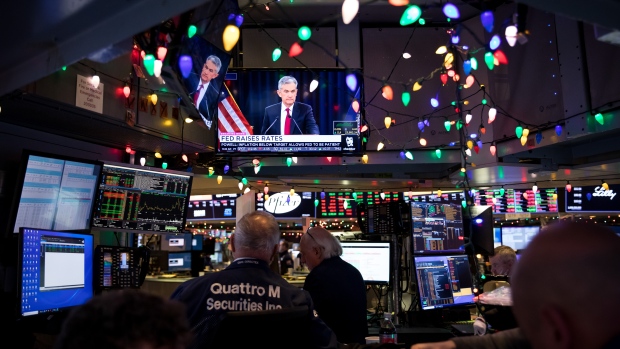Dec 20, 2018
Stocks slide as U.S. government shutdown woes add to Fed angst
, Bloomberg News

Volatility gripped financial markets a day after the Federal Reserve sent shock waves across assets, with the rising threat of a government shutdown adding to a litany of concerns buffeting equities. The dollar sank with crude oil.
The S&P 500 Index whipsawed throughout the day in heavy trading before closing at a 15-month low as investors debated whether the Fed set up the central bank for a policy error. Shares turned sharply lower after President Donald Trump hardened his demands in the showdown with Congress over funding the government. “I’ve made my position very clear -- any measure that funds the government must include border security,” the president said at White House event.
The Nasdaq Composite index slumped to the brink of a bear market, finishing almost 20 per cent off its August record. The S&P 500 is down more than 10 per cent in December, on track for its worst month of the record bull run.
Among the major stock moves:
The broader FAANG cohort of shares plunged more than 3 per cent and the group is now 25 per cent below its record. Twitter tumbled 11 per cent in the biggest rout since July. Tech high fliers GoPro and Snap skidded to all-time lows, each down at least 5 per cent. Walgreens Boots Alliance lost as much as 6.6 per cent to lead all but one of 30 Dow components lower. The S&P 500 has lost about 15 per cent this quarter, the most during the record bull run.
Currency traders took the Fed’s lowering of expectations for future hikes as a somewhat dovish turn. The weak greenback spurred a rally in developing-nation assets, sending an ETF that tracks the emerging equities to its best gain in a week. Treasury investors remained on edge after the Fed said quantitative easing was on “autopilot.” The front end of the yield curve rose, while longer-dated bonds saw rates holding steady near multimonth lows.
Crude added to anxiety on financial markets, with the American benchmark sinking below US$47 a barrel. And a renewed U.S. push against alleged intellectual property theft by Chinese nationals is contributing to uncertainty over the direction of the simmering trade conflict.
The Stoxx Europe 600 recovered some losses but closed broadly lower, while Japanese shares slid into a bear market. The pound trimmed a gain after Britain’s central bank said it now sees inflation slowing to below the 2 per cent target as soon as January. Benchmark 10-year Treasuries retreated after steep gains on Wednesday. The greenback slid against almost every major counterpart, helping the yen score its biggest gain since November 2017.
In Japan, 10-year bond yields fell to within three basis points of zero per cent. Bank of Japan Governor Haruhiko Kuroda said in a press conference Thursday that there was no problem if yields fell into negative territory, suggesting he has no plan to intensify the central bank’s tapering of asset purchases.
Here are some events investors will focus on in the coming days:
U.S. personal income and spending data are due Friday, along with a gauge of inflation.
And these are the main moves in markets:
Stocks
The S&P 500 Index fell 1.6 per cent as of 4:03 p.m. New York time. The Nasdaq Composite lost 1.6 per cent, a 15-month low. The Stoxx Europe 600 Index declined 1.5 per cent to the lowest in more than two years. MSCI’s emerging market index slid 0.8 per cent.
Currencies
The Bloomberg Dollar Spot Index sank 0.7 per cent to the lowest in six weeks. The euro climbed 0.7 per cent to US$1.1458, the strongest in almost two months. The British pound advanced 0.4 per cent to US$1.2662, the strongest in almost two weeks. The Japanese yen jumped 1.1 per cent to 111.26 per dollar, its biggest jump in 13 months.
Bonds
The yield on 10-year Treasuries gained four basis points to 2.80 per cent. Germany’s 10-year yield fell one basis point to 0.23 per cent. Britain’s 10-year yield dropped one basis point to 1.266 per cent.
Commodities
West Texas Intermediate crude decreased 4.2 per cent to US$46.14 a barrel. Gold jumped 1.4 per cent to US$1,260.24 an ounce, the highest in six months.








